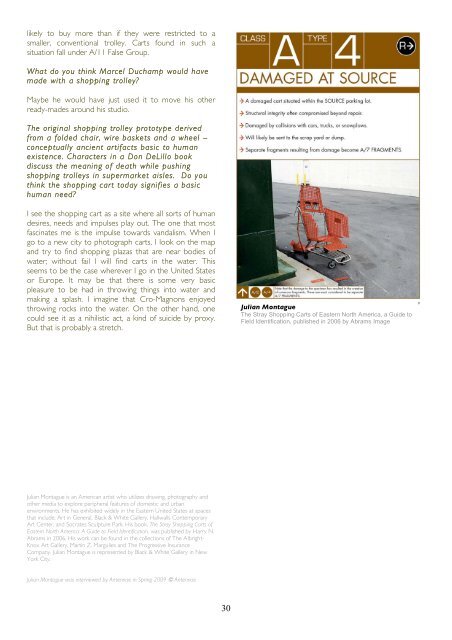M - Antennae The Journal of Nature in Visual Culture
M - Antennae The Journal of Nature in Visual Culture
M - Antennae The Journal of Nature in Visual Culture
You also want an ePaper? Increase the reach of your titles
YUMPU automatically turns print PDFs into web optimized ePapers that Google loves.
likely to buy more than if they were restricted to a<br />
smaller, conventional trolley. Carts found <strong>in</strong> such a<br />
situation fall under A/11 False Group.<br />
What do you th<strong>in</strong>k Marcel Duchamp would have<br />
made with a shopp<strong>in</strong>g trolley?<br />
Maybe he would have just used it to move his other<br />
ready-mades around his studio.<br />
<strong>The</strong> orig<strong>in</strong>al shopp<strong>in</strong>g trolley prototype derived<br />
from a folded chair, wire baskets and a wheel –<br />
conceptually ancient artifacts basic to human<br />
existence. Characters <strong>in</strong> a Don DeLillo book<br />
discuss the mean<strong>in</strong>g <strong>of</strong> death while push<strong>in</strong>g<br />
shopp<strong>in</strong>g trolleys <strong>in</strong> supermarket aisles. Do you<br />
th<strong>in</strong>k the shopp<strong>in</strong>g cart today signifies a basic<br />
human need?<br />
I see the shopp<strong>in</strong>g cart as a site where all sorts <strong>of</strong> human<br />
desires, needs and impulses play out. <strong>The</strong> one that most<br />
fasc<strong>in</strong>ates me is the impulse towards vandalism. When I<br />
go to a new city to photograph carts, I look on the map<br />
and try to f<strong>in</strong>d shopp<strong>in</strong>g plazas that are near bodies <strong>of</strong><br />
water; without fail I will f<strong>in</strong>d carts <strong>in</strong> the water. This<br />
seems to be the case wherever I go <strong>in</strong> the United States<br />
or Europe. It may be that there is some very basic<br />
pleasure to be had <strong>in</strong> throw<strong>in</strong>g th<strong>in</strong>gs <strong>in</strong>to water and<br />
mak<strong>in</strong>g a splash. I imag<strong>in</strong>e that Cro-Magnons enjoyed<br />
throw<strong>in</strong>g rocks <strong>in</strong>to the water. On the other hand, one<br />
could see it as a nihilistic act, a k<strong>in</strong>d <strong>of</strong> suicide by proxy.<br />
But that is probably a stretch.<br />
Julian Montague is an American artist who utilizes draw<strong>in</strong>g, photography and<br />
other media to explore peripheral features <strong>of</strong> domestic and urban<br />
environments. He has exhibited widely <strong>in</strong> the Eastern United States at spaces<br />
that <strong>in</strong>clude; Art <strong>in</strong> General, Black & White Gallery, Hallwalls Contemporary<br />
Art Center, and Socrates Sculpture Park. His book, <strong>The</strong> Stray Shopp<strong>in</strong>g Carts <strong>of</strong><br />
Eastern North America: A Guide to Field Identification, was published by Harry N.<br />
Abrams <strong>in</strong> 2006. His work can be found <strong>in</strong> the collections <strong>of</strong> <strong>The</strong> Albright-<br />
Knox Art Gallery, Mart<strong>in</strong> Z. Margulies and <strong>The</strong> Progressive Insurance<br />
Company. Julian Montague is represented by Black & White Gallery <strong>in</strong> New<br />
York City.<br />
Julian Montague was <strong>in</strong>terviewed by <strong>Antennae</strong> <strong>in</strong> Spr<strong>in</strong>g 2009 � <strong>Antennae</strong><br />
30<br />
Julian Montague<br />
<strong>The</strong> Stray Shopp<strong>in</strong>g Carts <strong>of</strong> Eastern North America, a Guide to<br />
Field Identification, published <strong>in</strong> 2006 by Abrams Image












